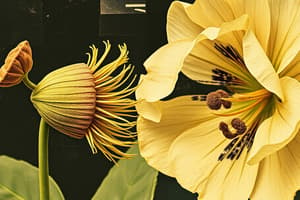Podcast
Questions and Answers
What is the primary purpose of pollination in plants?
What is the primary purpose of pollination in plants?
- To attract pollinators such as insects and hummingbirds
- To produce fragrances and scents
- To protect the other parts of the flower
- To produce seeds and offspring for the next generation (correct)
What is the function of the sepal in a flower?
What is the function of the sepal in a flower?
- To produce pollen grains
- To protect the other parts of the flower (correct)
- To provide a unique shape and color to the flower
- To attract pollinators
What is the part of the stamen that produces and disperses pollen grains?
What is the part of the stamen that produces and disperses pollen grains?
- Sepal
- Filament
- Anther (correct)
- Pistil
What is the sticky region at the top of the pistil that catches pollen grains?
What is the sticky region at the top of the pistil that catches pollen grains?
What is the part of the flower that provides a unique shape, color, and scent to attract pollinators?
What is the part of the flower that provides a unique shape, color, and scent to attract pollinators?
What is the primary function of a pollen tube during flower pollination?
What is the primary function of a pollen tube during flower pollination?
What is the main reason why plants have evolved to attract pollinators?
What is the main reason why plants have evolved to attract pollinators?
What percentage of plant pollination occurs through wind and water?
What percentage of plant pollination occurs through wind and water?
What is a characteristic of wind-pollinated flowers?
What is a characteristic of wind-pollinated flowers?
What is the consequence of successful pollination on the ecosystem?
What is the consequence of successful pollination on the ecosystem?
What is the primary purpose of the sticky and barbed pollen in plants that rely on animals for pollination?
What is the primary purpose of the sticky and barbed pollen in plants that rely on animals for pollination?
Which type of pollination involves the movement of pollen from one flower to another of the same plant or from the anther to the stigma of the same flower?
Which type of pollination involves the movement of pollen from one flower to another of the same plant or from the anther to the stigma of the same flower?
What is the advantage of cross-pollination over self-pollination?
What is the advantage of cross-pollination over self-pollination?
What is the estimated number of invertebrate species that are considered pollinators globally?
What is the estimated number of invertebrate species that are considered pollinators globally?
Which type of flowers do hummingbirds and sunbirds prefer?
Which type of flowers do hummingbirds and sunbirds prefer?
Flashcards are hidden until you start studying
Study Notes
Parts of a Flower
- A complete flower contains both male and female reproductive organs, but some flowers may only have one of the two.
- The four main parts of a flower are sepal, petal, stamen, and pistil.
Sepal
- The sepal protects the other parts of the flower and looks like tough green leaves surrounding the bud.
Petal
- The petals provide a unique appearance to the flower, attracting pollinators such as insects and hummingbirds with shape, color, and scent.
Stamen
- The stamen is the male reproductive part of the flower, consisting of an anther and a filament.
- The anther produces and disperses pollen grains containing male reproductive cells.
- The filament is the stalk supporting the anther.
Pistil
- The pistil is the female reproductive part of the flower, composed of the ovary, stigma, and style.
- The ovary contains the female reproductive cells and is found at the base of the pistil.
- The stigma is the sticky region at the top of the pistil that catches pollen grains.
- The style is the stalk of the pistil, found between the ovary and the stigma.
Pollination
- Pollination is the transfer of pollen grains from a flower's male anther to the female stigma.
- Pollination's primary purpose is to produce seeds and offspring for the next generation.
Methods of Pollination
- There are two methods of pollination: abiotic (wind and water) and biotic (insects and other animals).
- About 80% of plant pollination occurs with the support of animals, while the remaining 20% is through wind and water.
Wind Pollination
- Wind-pollinated flowers appear in spring, before or while the leaves are emerging.
- Characteristics of wind-pollinated flowers include lightweight, smooth, and small pollen, and large, feathery stigmas.
- Examples of wind-pollinated plants include conifers, grasses, cereal crops, ragweed, and cat-tail.
Animal Pollination
- Plants that rely on animals for pollination develop strategies to attract pollinators, such as visual cues, scent, food, mimicry, and entrapment.
- Plants produce sticky and barbed pollen for easier attachment and transfer to other flowers.
- Flowers display their petals, shape, color, and nectar guides to attract pollinators.
Types of Pollination
- There are two types of pollination: self-pollination and cross-pollination.
- Self-pollination occurs when the plant fertilizes itself, resulting in genetically identical offspring.
- Cross-pollination occurs when pollen is transferred from one flower to another of the same species, providing the offspring with desirable characteristics from both parents.
Importance of Pollination
- Pollination is essential for fertilization and production of seeds for dispersal and propagation.
- It is crucial for maintaining genetic diversity within a population and developing an adequate number of fruits.
- The ecosystem would not survive without pollination, and most crops and food products depend on successful pollination.
- Pollination also has environmental benefits, such as producing oxygen and purifying water.
Studying That Suits You
Use AI to generate personalized quizzes and flashcards to suit your learning preferences.



